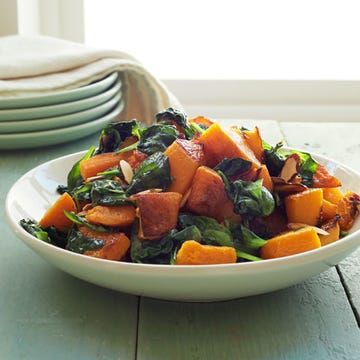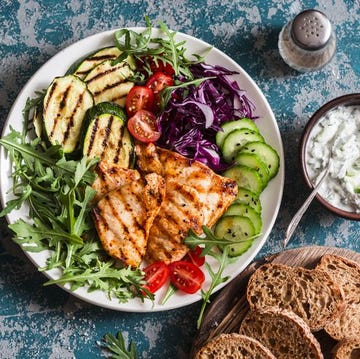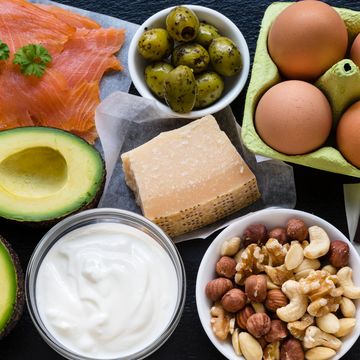From high-fat keto to anti-inflammatory Whole 30, new eating plans — and books explaining the method behind their menus — seem to be popping up every week. One of the latest comes courtesy of a reality TV star couple: Terry and Heather Dubrow. We asked a couple of registered dietitians to weigh in on the Dubrow Diet so you can decide if it's the right fit for you.
Who are the Dubrows?
Heather Dubrow's first claim to fame comes courtesy of Bravo's The Real Housewives of Orange County, which she starred on for several seasons, giving a viewers a look into her life as a stylish mom-slash-entrepreneur. She now dishes on her weekly podcast, Heather Dubrow's World. Her husband, Terry Dubrow, MD, is a famous plastic surgeon who stars on E!'s reality show, Botched.
Together, the duo have a skincare line, co-host the Dr. and Mrs. Guinea Pig podcast, and developed a diet plan that ranked as the second most popular diet search trend of 2018.
What is the Dubrow Diet?
Released in October 2018, The Dubrow Diet: Interval Eating to Lose Weight and Feel Ageless is a lifestyle inspired by Terry's feast-and-famine eating style during his medical school residency. He found he actually felt better eating less often, and decided to dig into the research behind intermittent fasting, or "interval eating" in Dubrow vocabulary.
"The Dubrow Diet sets boundaries on when to eat and when not to eat," says Ali Webster, PhD, RD, a registered dietitian and the associate director of nutrition communications at the International Food Information Council Foundation.
To test out Terry's interval eating theory and its ability to gobble up aging-promoting toxins, the Dubrows organized their own six-month trial with 100 participants. The average weight loss was 48 pounds, Terry says, and 98% of people were satisfied with the changes from their baseline. As a result, their book description claims their diet can:
- Reprogram cells to use fat as fuel instead of sugar
- Fight disease-causing inflammation
- Boost energy
- Improve appearance and slow the aging process
But where does one start? The Dubrow Diet is split into three phases:
Phase One: "Red Carpet Ready"
To "shock" your body, during the first two to five days of the diet your calorie allotment is squeezed into an 8-hour window, say, 10 a.m. to 6 p.m. That means you fast the other 16 hours. The foods recommended fall low on the glycemic index and include lean protein and non-starchy vegetables, plus a bit of healthy fats, fruit, and complex carbs. Alcohol is off limits.
Phase Two: "Summer is Coming"
Until you reach your goal weight, you'll add in slightly more healthy fats and complex carbs and can indulge in a bit of alcohol. That is, if you keep everything within your eating window of 8 to 12 hours per day. During this "summer prep" period, you can choose a slow, medium, or fast track, with varying fuel windows and cheats (one cheat snack, cheat meal, or cheat day per week), depending on how quickly you want to lose weight.
Phase Three: "Look Hot While Living Like a Human"
After completing the first two phases, dieters should follow the third phase indefinitely to maintain their weight loss. That means fasting for 12 hours five days a week and fasting for 16 hours the other two days a week.
What is interval eating — and is it different from intermittent fasting?
Calling it intermittent fasting brings to mind "skinny, tired people," according to Heather — although that's essentially what interval eating is, says Lauren Harris-Pincus, MS, RDN, a registered dietitian nutritionist in New York City, founder of NutritionStarringYOU, and the author of the cookbook The Protein-Packed Breakfast Club.
"The only difference between interval eating and intermittent fasting are the words you use. There are a few types of intermittent fasting, including 'TRE,' or time-restricted eating, which limits your eating window in a given day. That's what the Dubrows are promoting," says Harris-Pincus.
What can I eat on the Dubrow Diet?
"In a nutshell, the diet is low in calories and carbohydrates," says Ashley Reaver, RD, a registered dietitian at Ashley Reaver Nutrition LLC in Oakland, California. While the foods-allowed list expands slightly with each phase, a mix of protein, fat, and complex carbs are always recommended, including:
- Avocado
- Nuts and nut butters
- Yogurt
- Poultry
- Seafood
- Leafy Greens
- Berries
- Oatmeal
- Quinoa
- Coffee
- Tea
What are the potential benefits?
Sure, a candy bar at noon is the same as a candy bar at midnight, but interval eating can be helpful for people who have a difficult time managing boredom bites.
"Intermittent fasting works for many individuals because it sets limits on the times that you can eat," says Reaver. She adds that for many people, food decisions made after 9 p.m. aren't usually healthy. But intermittent fasting eliminates late night eating, which means it'll reduce the number of calories a late night snacker consumes in each day, leading to weight loss.
"If time-restricted eating works within your lifestyle, it may be beneficial and assist with weight management, but any diet should lead to permanent behavior and lifestyle changes," Harris-Pincus says. "If it's something you can't continue for the long term, don't start."
What are the health concerns to keep in mind?
Research on interval eating is limited, and has mostly been performed on animals, Harris-Pincus says. While one human study found it may help lower cholesterol, another showed it was no better than calorie restriction for weight loss.
While both meal timing and food quality matters, Harris-Pincus worries about interval eating tinkering with natural circadian rhythm: "Research on circadian rhythm has shown that our bodies handle food much better earlier in the day for weight management, control of blood sugar, and cardiovascular health. By encouraging any eight-hour window, some may skip breakfast and eat much later in the day."
For that reason, Harris-Pincus says if her clients want to follow a plan like this, she suggests an eating window of 9 a.m. to 5 p.m. or no later than 10 a.m. to 6 p.m. for the most benefits.
Reaver agrees, adding that a consistent eating agenda, with eating wrapping up a few hours before bed, is the most beneficial schedule to reduce blood glucose levels, improve sleep, speed up muscle recovery, and reduce inflammation.
Reaver also adds that the following populations should steer clear of the Dubrow Diet:
- Premenopausal females, "because the starvation periods may interfere with natural sex hormone production and regulation. This can have a lasting impact on overall hormone health and metabolism."
- Anyone with a history of an obsessive relationship with food. "Diets with strict rules and strict foods that are off limits may trigger individuals with turbulent diet histories."
- Those with diabetes, since fasting drastically impacts blood sugar.
The bottom line on the Dubrow Diet.
According to Reaver, before beginning any diet, you should ask yourself whether or not you could follow the diet forever. If the answer is yes, then it's probably an okay diet to follow. If the answer is no, then you can expect to regain the weight once you stop following the diet. "The best 'diets' are ones that encourage overall eating patterns without being restrictive," she says.
Harris-Pincus echoes that sentiment, and tells her clients that "any diet you can't follow on a bad day is a diet you shouldn't try." Another thing to note: Your liver and kidneys do all the cleansing your body requires — no detox, starve session, or "shock" phase necessary.
Karla Walsh is a Des Moines, Iowa-based freelance writer and level one sommelier who balances her love of food and drink with her passion for fitness. (Or tries to, at least!) Her writing has been published in Runner’s World and Fitness Magazines, as well as on Shape.com, EatThis.com, WomensHealthMag.com, and more.
















